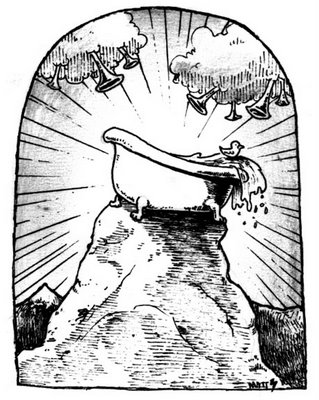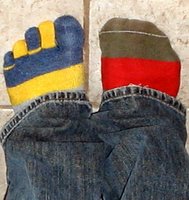Exposé on Fake Outrage? How Dare You!

A brisk wind off the northwest shore of Lake Michigan drives sleet into the faces of thousands of fans. They shiver in various combinations of midnight blue, brown, and orange. For many hours, devoid of cover or respite, they have been waiting in the parking lots that surround Soldier Field like so many concrete ice-plains.
They huddle around smoke-pits and drink massive quantities of beer, which seems to warm them up while dilating their blood vessels and making the prospect of hypothermia that much more probable.
They are like the Mongol hordes crouched around their camp-fires, greedily devouring the spoils of recent victories and eagerly anticipating those to come. They have been waiting for several hours and will be waiting several more before they are allowed to file into the stadium to watch the event they are here for, the game they paid a ridiculous amount of money to attend, the NFC championship game between their beloved Bears and the upstart, feel-good story of the year, the New Orleans Saints.
A rare breed of fan stands out like gold dinghies in a sea of brown and blue. Those bold enough to follow their team to an opposing team's stadium. A small number of Saints fans have braved the weather and the drunken Bears fans to watch what, in all probability, could be the last game their team plays all year. They endure verbal abuse, suffer the threat of impending physical violence, and are assaulted with fan-crafted signs like:
"Bears finishing What Katrina Started."
I must say that when I saw this sign displayed prominently alongside Al Jones' recent article in the Sun Herald, I laughed.
Seriously, I'm no monster, but a joke is a joke, and in the fine tradition of South Park, The Onion, and the Colbert Report, this outrageous prophecy struck me as witty.
Did the folks who read this slogan—Bears and Saints fans alike—honestly believe that it was created out of a sincere desire for disaster? Did they read it as a command for rampaging brown bears to descend upon the recovering gulf city and finish off the victims of the greatest natural disaster in US history? Of course not.
Is the taste of the slogan questionable? Perhaps. Will it outrage those with thin skins? Absolutely.
Because if there is one thing professional sports leagues are in the business of perpetuating—other than illegal substance abuse, unplanned pregnancies, domestic violence, and inflated egos—it’s fake outrage.
Fake outrage!? How dare you!
Yes, fake outrage.
Many people, media pundits especially, fail to realize that sports exist for one reason: Entertainment. And to think that the concept of entertainment is limited to the playing field is complete folly.
Fans easily get sucked into all of the extraneous 'stuff' that goes hand-in-hand with professional sports. People revel in the drug scandals, the arrests, and the outrageous behavior of figures that have become this century's equivalent to medieval jesters. And just like jesters of old who could do what no one else in their right mind could do—insult the king, mock unassailable institutions, etc.—professional sports players appear to have cart blanche when it comes to acting like complete jackasses.
Decent, intelligent fans see through this sort of thing and laugh, shrug their shoulders, and wish most folks would ignore such behavior and let it slip quietly away. But many fans become outraged!
Sort of.
Because they aren't really outraged!
They are being entertained by sports, albeit peripherally. And to perpetuate the circle of fake outrage we need the media to deliver to the rubes what they so badly want.
Fake outrage!
As such, Jones' article in the Sun Herald is a complete joke.
So let me get this straight. Some Saints fans traveled to Chicago for the most important game in either team’s recent history and expected to be greeted as equals? Of course they were going to be heckled! Did the fact that their city was recently ravaged by a category 5 hurricane exempt them from the abuse every other team's fans would have expected in their place? Are you kidding me?
Were any visiting fans physically assualted? Jones never tells us, but my guess is no. A drunken fan can compete alongside the Terrell Owenses of the world in the Universe's Biggest Jackass competition, but it takes a special sort of sociopath to commit violence toward another human being. If physical hostility did occur, then perhaps Jones' story would have held a little water. But as it stands, his article is yet another dull contribution to the barrage of "which team's fans are the most uncouth?" stories endlessly recycled every year from here to ESPN.com to eternity.
Well, which fans are the most uncivilized? Oakland fans? Eagles fans? Browns fans? Oh, that's right—I guess we'll never know. And why is that? Because all the real fans could care less what the scurrilous sign-makers are doing.
They’re too busy watching the actual sport everyone supposedly loves so much.
Labels: Toe-Sock Doug
Read more!







